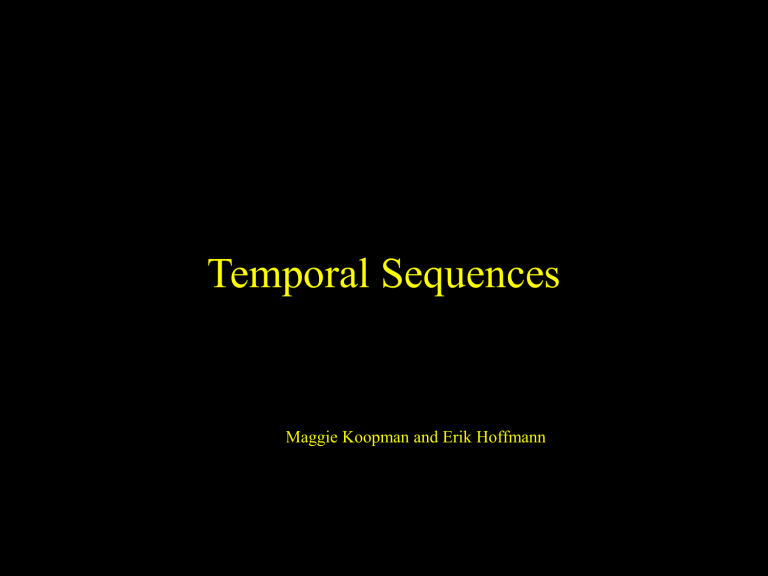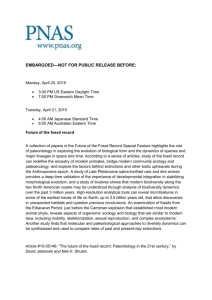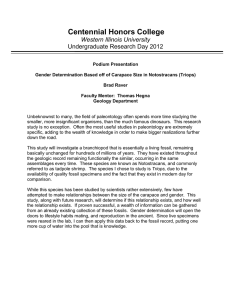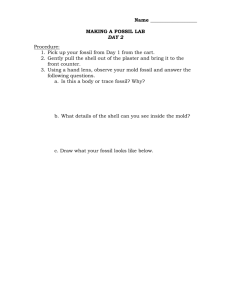Fossil record II: Temporal sequencing

Temporal Sequences
Maggie Koopman and Erik Hoffmann
0.0
Now!
1.0
First hard parts
First multicellular
2.0
First eukaryotes
3.0
4.0
First life!
The beginning!
Time is on my side
1.5 billion years
The Outcrop
Sometimes you have a lot to work with...
The Outcrop
...and sometimes you don’t!
The Outcrop
Dooley et al., 2004
No crystalline rocks
• No absolute dating
• Imprecise age calibration
2 meters = 10 yrs or 10 million?
Dooley et al., 2004
The Outcrop
Unconformities
• Stratigraphic gaps caused by non-deposition or erosion
• The bigger the time window, the bigger and more frequent the gaps will be
Dooley et al., 2004
The Outcrop
Cover
• Prevents examination
• vegetation
• loose sediment/soil
• snow/ice/permafrost
The (so-so) Outcrop
Constant Motion
100 km
Modified from Tibert et al., 2003.
No Outcrop!
• Resolution depends on depositional rates
– High rates allow high resolution
– Low rates allow low resolution
– Negative rates erase the record
• Not all environments are created equal!
Schindel, 1982
Dooley et al., 2004
Gingerich, 1983
Limitations
• Preservable hard parts only!
• Morphological change only!
Limitations cont.
• Can’t detect fine changes.
• Small directional changes followed by reversals show up as variability within the population
Geary et al., 2002
Punctuated Equilibrium
• Long periods (relative to species durations) of morphological stasis coupled with brief periods of very rapid morphological change
• Stasis does NOT mean nothing is happening
• Changes in soft parts
• Changes in tolerances/behaviors
• Small directional morphological change followed by doubling back
Biases
• Lineage (size, hard parts, frequency)
• Location (range, availability)
• Temporal resolution ((sub)stage level)
• Character sets
• Usefulness/Interest
Does the fossil record need to be complete?
Can we work around the gaps?
Can we derive viable sequences from a spotty record?
Quality of the fossil record through time
M. J. Benton, M. A. Wills and R. Hitchin
What does this paper do?
• Offers evidence that the fossil record provides uniformly good documentation of past life.
•
Assesses the congruence between stratigraphy and phylogeny.
The Congruence Metrics
• Valid techniques for comparing large samples of cladograms to try to estimate variations in congruence between the fossil record for different groups of organisms and for different habitats
• RCI (relative completeness index)
• GER (gap ratio index)
• SCI (stratigraphic consistency index)
Depend on branching point estimates and calc. Of ghost ranges
Stratigraphic consistency index
(Huelsenbeck 1994)
• Fit of the record to the tree= proportion of the nodes that are stratigraphically consistent.
•Significance of the fit= generate a null distribution for SCI under the hyp. That the statigraphic fit is not better than expected at random.
Figure 2
• Hypothesis 1: congruence is better than random (bars to the left)
• Alternative hypothesis: congruence is worse than expected from a random model: direct conflict between data (bars to the right)
RCI SCI
Fig 1 a/b Benton et al 1999
What causes poor matching of age and clade data?
Bias in the metric
• Difference in quality of trees
• Difference in quality of fossil record
• Stratigraphic problems
• Taxonomy
• Sampling density
Molecular Clock Divergence Estimates and the Fossil Record of Cetartiodactyla
Jessica M. Theodor
J. Paleontology 78 (1), 2004, p 39-44
Why this paper?
• Ties molecular clocks to the fossil record
• Introduces cetaceans and hippopotamids
Molecular Clocks vs. the Fossil Record
• Artiodactyla/Cetacea split – 60 Ma
– Earliest fossil whales 53.5 Ma
– Earliest fossil artiodactyls 55 Ma
• Odontocete/Mysticete split – 34-35 Ma
– Rare at 34 Ma, good record ~30 Ma
• Hippopotamid/Cetacean split
– Earliest fossil whales 53.5 Ma
– Earliest fossil hippos 15.6-15.8 Ma
» Anthracotheres - ~43 Ma
• New study using one mitochondrial and one nuclear gene sequence
Boisserie et al., 2005
Take home messages
• The fossil record is necessary to calibrate molecular clocks (and refute the bad ones)
• The fossil record fills gaps in phylogenetic trees, allowing us to confirm evolutionary sequences
References
Benton, M.J., M.A. Wills, and R. Hitchin 2000, Nature. 403, 534-537
Benton, M.J. 2001, Proceedings of the Royal Society of London B. 268, 2123-2130
Boisserie, J.-R., F. Lihoreau, and M. Brunet 2005, Proceedings of the National Academy of Science 102
(5), 1537-1541
Dooley Jr., A.C., N.C. Fraser, and Z.-X. Luo 2004, Journal of Vertebrate Paleontology. 24 (2), 453-463
Geary, D.H., A.W. Staley, P. Muller, and I. Magyar 2002, Paleobiology. 28 (2), 208-221
Gingerich, P.D. 1983, Science. 222, 159-161
Gingerich, P.D. 1984, Science. 226, 995-996
Gingerich, P.D. 2002, Cetacean Evolution
Gould, S.J. 1984, Science. 226, 994-995
Huelsenbeck, J.P. 1994, Paleobiology. 20 (4), 470-483
Koch, C.F. 1978, Paleobiology. 4 (3), 367-372
Levinton, J., L. Dubb, and G.A. Wray 2004, Journal of Paleontology. 78 (1), 31-38
Lihoreau, F., and J.-R. Boisserie 2004, Journal of Vertebrate Paleontology 24 (Supp. 3), 83A
Rose, K. 2001, Science. 293, 2216-2217
Schindel, D. 1982, Paleobiology. 8 (4), 340-353
Schopf, T.J.M. 1982, Evolution. 36 (6), 1144-1157
Theodor, J.M. 2004, Journal of Paleontology. 78 (1), 39-44
Tibert, N.E., R.M. Leckie, J.G. Eaton, J.I. Kirkland, J.-P Colin, E.L. Leithold, and M.E. McCormick
2003, in Olson, H.C. and R.M. Leckie, eds., Micropaleontologic Proxies for Sea-Level Change and
Stratigraphic Discontinuities : SEPM Special Publication No. 75, 263-299
Wills, M.A. 1999, Systematic Biology. 48 (3), 559-58





